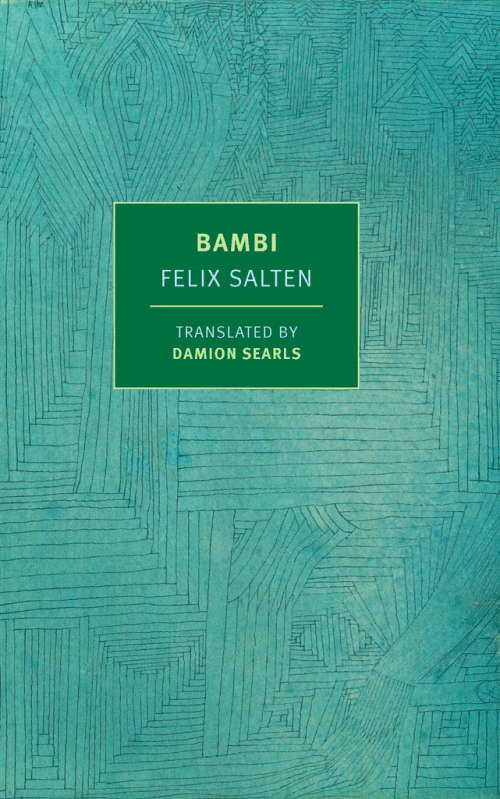This year marks one hundred years since a Viennese newspaper first serialized Felix Salten’s novel Bambi. A new translation by Jack Zipes emerged from Princeton University Press earlier in the year. This fall, a reissue from New York Review Books Classics—translated by Damion Searls, with an afterword by Mark Reitter—offers readers another look at this enduring coming-of-age story. For a slim book, Bambi carries great allegorical heft—political, ecological, and existential—and is also a moving meditation on attention and solitude.
Searls’ poetic translation immerses the reader in forest life, putting us ground level with the animals, for better and worse. Days filled with foraging, rest, and communication evoke the full lives these nonhumans lead. Salten casts milestone moments in awe-inducing light, as in Bambi’s first visit to the meadow with his mother. Having spent much time walking dark paths, obscured by tree-enshrined cloisters, the open expanse overwhelms the young fawn with joy: “Back in the forest, the sun had appeared only as occasional sunbeams or delicate clots of golden light playing through the branches. Now its hot blinding power held absolute sway over him as he stood in a blessed heat that shut his eyes and opened his heart.” The sense of wonder is galvanizing. It creates a reverence, emotional and physical, for the sublime—the astonishment of encountering something beautiful up close, in sharp definition, for the first time.
Salten’s view of the forest also captures nature’s horrifying events. During a thunderstorm, “when the lightning flashed, when the thunder boomed, Bambi was senseless with horror; he thought the world was being torn to pieces.” The storm’s visceral effects soften as, “[t]he rain became gentler… and no one was scared to be outside anymore. That feeling was past—the rain had washed it away.” The forest is a sensory panorama, an ecosystem brimming with physical and emotional textures that can threaten and terrify, while also ushering in “gentler” rain and relief.
Within this complicated setting, awareness is crucial. The ability to find joy in the meadow and fear in a rainstorm becomes a survival skill with the appearance of the hunter, known as He/Him. Hearing an unsettling snap of twigs or ominous crush of leaves may signal His approach. Detecting His scent in the forest urges animals to run. Bambi first notices the hunter by “a strange smell, strong and sharp and more than agitating—it’s enough to put him in a frenzy.” This atmospheric panic is heightened when the fawn sights the hunter: “The face radiates a fearsome horror. Cold terror. It has a monstrous, disturbing, paralyzing violence in it, and is almost unbearably painful to look at, yet Bambi stands there and doesn’t take his eyes off it.” Bambi’s intense reaction to the hunter’s smell is fully realized through visual observation; the threat becomes concrete. It’s the difference between smelling smoke and witnessing a blaze.
A later collision between the hunter and forest animals escalates into a nightmare in which “Bambi heard footsteps and looked back. There He was, coming out from the bushes, there, and there, and there. He appeared everywhere, lashing out in all directions, thrashing the shrubs, drumming on the tree trunks, and shouting in a terrifying voice.” The lyricism in these lines is propulsive. Repetition paired with short clauses has the effect of an accelerated heartbeat. The lashing, thrashing, and drumming conjure violence and danger that culminate in Bambi’s loss of his mother.
The shift thrusts Bambi toward independence, calling back to early admonishment he received from an Old Stag, “Can’t you be alone?” The tension between the animals’ dependence on each other and the push toward self-reliance evokes somber adolescent reckonings: losing a parent, or understanding this loss will happen; seeking acceptance while longing to define oneself; death and its attendant solitude.
The subtle sadness that thrums through the book was lost to more episodic portrayals in Disney’s 1942 animated adaptation. In the film, the death of Bambi’s mother and a forest fire check off thematic boxes of parental loss and human carelessness toward nature. The fawn awkwardly gliding—and wiping out—on a frozen-over pond conjures the magic of his first meadow visit. Nuance and surrounding stillness amplifies emotional resonance in the book; the film relies on emotional peaks and valleys.
Alongside the novel’s prolonged bleakness, the narrative progresses with plainspoken clarity: “Time passes…”; “Winter went on and on”; “It was summer, and blazing hot.” These subtle and distinct shifts acclimate readers to new seasons in the forest and the lives of its inhabitants. Time passes at a clip, the seasons change, and Bambi moves from one life stage to the next. The matter-of-fact narration frames these changes as a part of everyday life. Practical attention is paid to love, despair, and loneliness; we never linger too long in one emotion or another, one triumph or misfortune; each event is organic.
As life’s rhythms accumulate, cyclical themes emerge, and there is tension in these dichotomies: the balance between life and death, night and day, abundance and scarcity, safety and danger, community and solitude. An especially moving chapter details a dialogue between two oak-tree leaves on the cusp of falling from their branches before winter hits: “‘I wonder if it’s true,’ said the first, ‘if it’s really true that others will come and take our places when we’re gone, and then others still, again and again….’” This conversation adds a bittersweet note to the seasonal shift. The leaf is curious about future generations. Underlying this replacement, however, is the death of the leaves. The nod to something larger, beyond the self, is a surrender to the eternal and ongoing.
The coming-of-age narrative that follows Bambi from fawn years to adulthood is another prominent cycle. Bambi’s relationships—with his parents, his romantic interest, and peers—evolve as he matures from a reliant fawn to an independent stag, as does his curiosity. The fawn’s early eagerness to learn about the world around him—What is this? Who is that? Why are things the way they are?—deepens as the book progresses. The questions intensify as well as the stakes: safe times to visit the meadow; a bird’s warning call; the hunter’s worrisome scent curling along the paths and through the leaves. Growth and self-actualization are steered by curiosity and tenderness, feeling one’s way through the world to learn, only to wake the next day and find that knowledge entangled in a new set of questions and complications.
Salten’s characterization of the hunter is similarly complex. He’s initially introduced as a violent and obliterating presence. His scent invokes a chain reaction in the forest—animals warn one another, leaves crunch underfoot, birds call—while the gun he carries prompts debate. Some deer describe it as a “third hand” while another insists it’s a tooth. The hunter attains a mythic status among the animals. One hopeful doe, a “girl who was almost grown-up,” points out a capacity for redemption. She says, “It’s said that one day He will come among us and be gentle like we are. He will play with us, the whole forest will be happy, and we will be reconciled.” An older deer refutes this as “nonsense.”
In a later scene, however, a deer believed to have died returns to the forest. Though the hunter inflicted the injury, the deer recounts how He also nursed him back to health. Our sense of the hunter flickers with the possibility of redemption. The reprieve is short-lived when an animal notes a mark on the healed deer’s neck. The recovered deer shares it’s from a collar. The hunter’s seemingly selfless gesture fizzles upon learning he held the deer captive after healing him. He may not have a redemptive arc, yet our understanding of the hunter, even if only briefly, transcends the good-evil binary to illustrate the lifelong work of knowing, and learning to re-know, those around us and the world we inhabit.
While walking the forest, Bambi and the Old Stag see a wounded old fox emerge from the bushes, a hunting dog on his heels. The old fox pleads with the dog for his life. Yet the dog is relentless, barking to call the hunter. The old fox points out, “‘We’re practically brothers… you and I….’” More forest animals join the fox, calling the dog a traitor. The dog confesses his devotion to the hunter, admonishing them because, “He is all-powerful! He is above us!” before he kills the fox in a fatal fight. The moment deepens our understanding of the novel’s nonhuman animals. The hunter’s violence, however abhorrent, is expected, yet the dog’s actions are an unthinkable betrayal: giving up one’s own kind to a violent force.
Even the hunter’s mythic status has deeply existential implications. Witnessing the hunter’s body on the forest floor, the Old Stag who guides Bambi through the forest says, “He is alongside us, just like us” and also notes “There is someone above us all… above us and above Him.” His fate insists every human and nonhuman animal is subject to the universe’s life-and-death laws.
Complicating our perceptions of its characters and the circumstances surrounding their survival, Bambi’s larger questions launch beyond their initial asks, resulting in a transcendent story that refuses to sit still. Carrying from youth through adulthood, through wonder, disillusionment, and still moments that afford us deeper reflections, the book is a coming-of-age story and an existential meditation on life. It’s a dark ecological fairy tale that refracts the devastating impact human animals have on our natural world. At the same time, the story confronts the harm individuals may inflict upon each other. Salten, who was Jewish, lived much of his life in Vienna. In this context, Bambi is an allegory for Jewish life in post-World War I Europe. It’s a story about nonhuman animals that asks human animals to reflect on the ways we treat one another and the influences that guide our behavior.
In the afterword, Paul Reitter notes Salten’s varied career pursuits and interests, which included supplementing work at an insurance agency with writing projects, newspaper editing, founding a cabaret, to name a few. Given Bambi’s ecological concerns, readers may consider the author’s hunting hobby as complicated, ironic, or fitting. Yet such details point to a professional and personal life as prismatic as the setting Salten paints, the characters he casts, and the story he tells. The NYRB Classics edition reacquaints us with an evergreen tale about the interwoven nature of living things, our responsibilities to the planet and each other. In the woods, as in this world, to survive is to surrender to tenderness as well as brutality, to fine-tune our attention and bring clear-eyed intention to our choices and behaviors. A century after its first appearance, Bambi remains a timeless landscape of complexity amid life’s finite parameters.

FICTION
Bambi
By Felix Salten
Translated from the German by Damion Searls
NYRB Classics
Published September 20, 2022

